How has Starlink changed from SpaceX
Time is running fast. It seems that yesterday we were surprised by SpaceX's super-ambitious plans to put 12,000 satellites into orbit, and now the news of the week was the launch of the first sixty vehicles. In some ways, the project has changed, and, in my opinion, it is interesting to compare the current state with the plans that excited the public in 2016 and 2017.
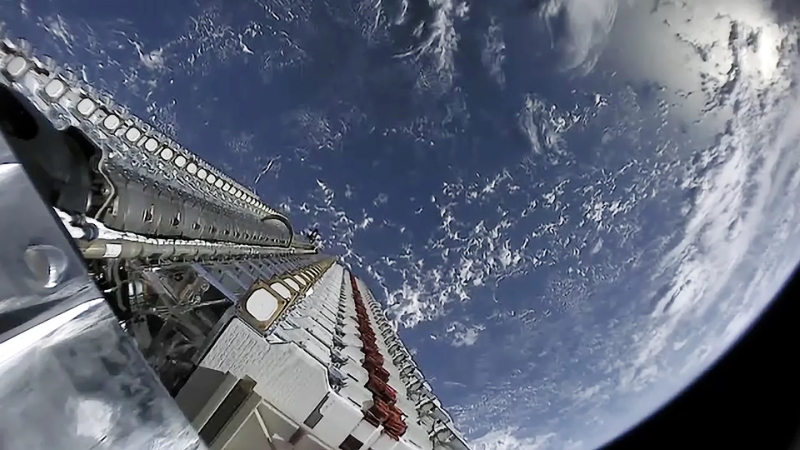
Starlink satellites on the dispenser, SpaceX photo
First of all, the physical characteristics of the satellites themselves have changed. In the application of 2016, their weight was indicated as 386 kg, and the dimensions (without solar panels) were 4x1.8x1.2 meters. As a result, according to approximate calculations, one Falcon 9 launch vehicle would be able to derive approximately 23 satellites by mass, and a total of around 8 would fit under the fairing. Test MicroSat-2A / B had a mass of approximately 400 kg and dimensions of 1x0.7x0.7 meters, but due to their experimental nature, this did not mean anything. So, when on May 12, a photo of a fairing appeared under Twitter on Mask, under which 60 flat satellites fit, this was a big surprise.

Dispenser satellites, SpaceX photo
')
The mass of the apparatus that went into orbit turned out to be equal to 227 kg, and the size can be estimated from the diameter of the fairing as approximately 2.4 x 1 meter. Such an engineering trick makes it much easier to launch, but it will be interesting to read sometime (for the time being, these data are not published) what processes SpaceX uses in their production. Until now, the satellite remains a device, the final assembly of which is relatively slow and mostly manual. And each device must be subjected to lengthy and rigorous testing, which also takes time and resources.
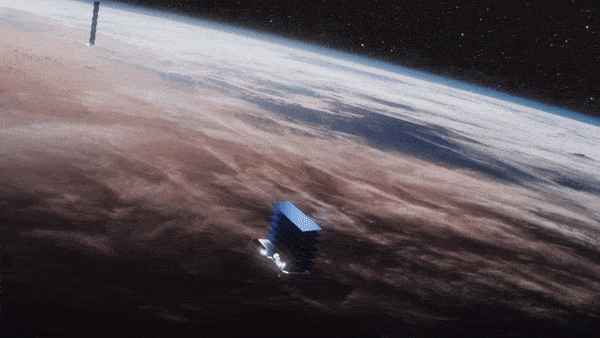
Solar panel deployment, SpaceX animation
The design of the satellites, unfortunately, was not disclosed, so that we can not assess how much it has changed. But at least one fact can be established. In the original application of 2016, two solar panels of 6x2 meters were mentioned in the open state, while the Starlink satellites launched had one, but comparable area (12 sections about 2.4 m long and less than a meter wide). But phased antennas for communication with subscribers were also mentioned in the original application, so nothing has changed here.
A curious story happened with orbital parameters. The initial application featured an orbit altitude of 1150-1325 km. And, when experimental MicroSat-2A / B flew in the spring of 2018, they were expected to raise the orbit from 511 km to 1125, and this was even confirmed by plans that SpaceX sent to the Federal Communications Commission (FCC) shortly before launch. However, both satellites remained in their original orbit, which caused talk of their breakdown. SpaceX officially denied this, and soon a new letter appeared in the FCC, which said that an altitude of 500 km gives new possibilities, simplifies the design and reduces the signal delay, so that the satellites will remain on it. As a result, the fact that the first Starlink satellites were put into orbit of 440 km and will rise to the target of 550 km was, in general, expected. Given the large number of vehicles, this has at least one useful feature - broken satellites will independently go out of orbit within a reasonable time (called a year and a half range).
Another difference is that the experimental devices were launched into a polar orbit, while the first serial ones were launched into an orbit with an inclination of only 53 °. The application of November 2018 states that from this inclination satellites will be able to serve subscribers up to about 57 latitude, and those who are higher will be provided with a service in polar orbits, the number of which is not indicated - all 1584 satellites will have to work in orbit 53 ° inclination. It seems that Starlink interest is focused so far on customers no higher than 57 latitude.

Starlink satellite division, footage from broadcast
The most dramatic number, the number of devices in the group, also underwent changes. After the FCC sent applications for mega-groups of hundreds and thousands of satellites, the commission asked a reasonable question: “what if these gentlemen just want to stake out the frequency and orbital range without unfolding the constellation in the foreseeable time?” And imposed a limit of nine years - six need to deploy at least half of the grouping, and for the remaining three to run the rest, otherwise the application is canceled, and the number of satellites is frozen on the already running. A clear deadline has had a positive effect on the industry - SpaceX has not formally abandoned plans to launch some 12,000 satellites sometime, but it’s really only 1584 plans so far. And by the end of the year, at least two more and six starts are expected, depending on how the first series.
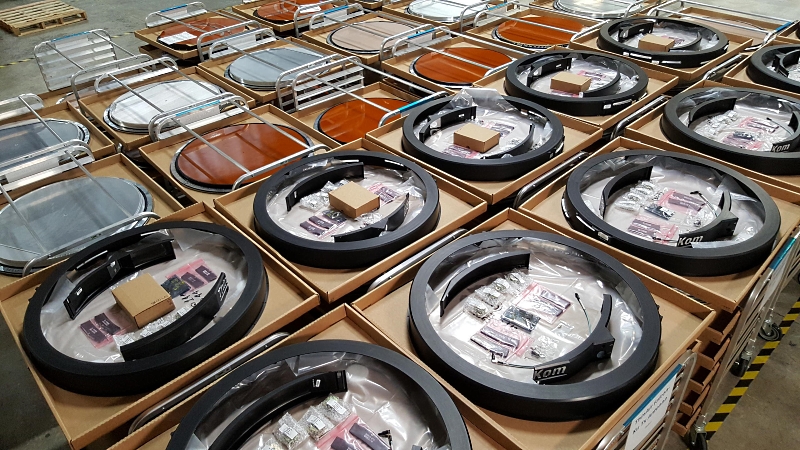
ThinKom Phased Array Antennas, ThinKom Photos
Until now, little is known about the ground stations that will communicate with the satellites. Contrary to the tenacious myth, it’s impossible to get Internet from Starlink from ordinary phones. And it is precisely the management of the importation of communications equipment, and not the "jamming of satellites" that will allow countries, if desired, to control their Internet markets. In a recent interview, Musk said only that the ground station would use a phased array antenna the size of a pizza box. Theoretically it will be possible to put such a station on a car, but the question rests on the price, which has not yet been called. In general, it is worth noting that antennas with phased arrays are already found on ships and aircraft, but have not yet spread to the consumer electronics market.
It is also funny that the myth about the free of the Internet from SpaceX is still tenacious. Starlink is a commercial project, and in a fresh interview Musk said that the system will be able to work with 800 satellites, and will be able to become competitive at about 1000. Specific prices and tariff plans have not yet been named. So if you suddenly see something like “FREE SPACEX STARLINK” in the list of Wi-Fi networks, then this is pranksters at best, and banal scammers at worst.
The ambitious project Starlink does not come to an empty market - the wired Internet has already spread widely on the surface, and they are going to introduce 5G for mobile. For remote subscribers with little traffic, there is Iridium, Globalstar, Orbcomm, or even the domestic "Messenger" . And in parallel, I have already started launching my satellites, a project similar to Starlink OneWeb. So, the future of Starlink is almost impossible to predict, but at least it is certain that it will be interesting to watch.
Speaking of observations. While the satellites are flying in a group, a strip of bright spots looks nice in the sky. Amateur astronomers and astrophotographers have been watching it since launch. Personally, the strip seemed to me noticeable only by lateral vision, but on the net you can find beautiful photos, videos and animations. And you can find out when the Starlink train will fly over you, for example, here or here .
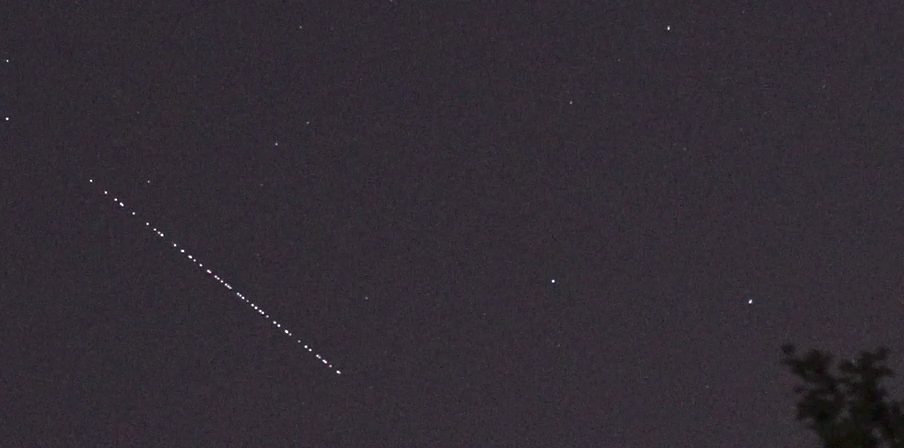
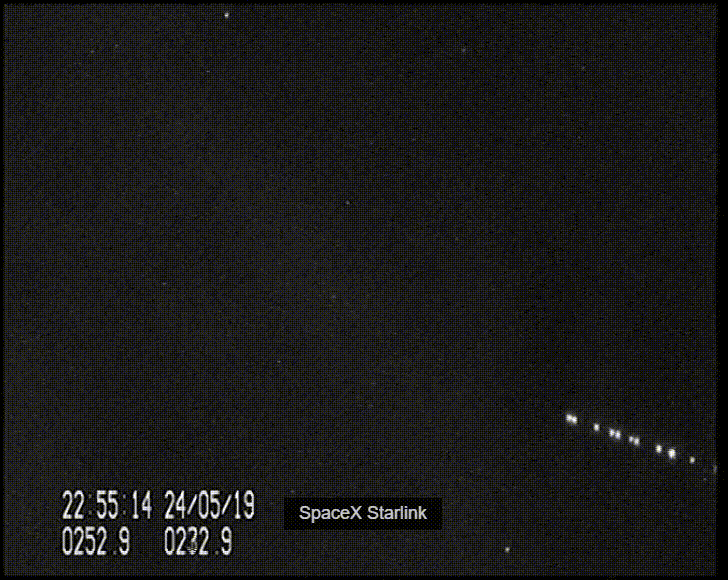
A small announcement: on May 30 - June 1, I will be in St. Petersburg, 30 I will read a lecture on “Apollo program stories” ( register here ), then I will be on SQADays-25.

Starlink satellites on the dispenser, SpaceX photo
First of all, the physical characteristics of the satellites themselves have changed. In the application of 2016, their weight was indicated as 386 kg, and the dimensions (without solar panels) were 4x1.8x1.2 meters. As a result, according to approximate calculations, one Falcon 9 launch vehicle would be able to derive approximately 23 satellites by mass, and a total of around 8 would fit under the fairing. Test MicroSat-2A / B had a mass of approximately 400 kg and dimensions of 1x0.7x0.7 meters, but due to their experimental nature, this did not mean anything. So, when on May 12, a photo of a fairing appeared under Twitter on Mask, under which 60 flat satellites fit, this was a big surprise.

Dispenser satellites, SpaceX photo
')
The mass of the apparatus that went into orbit turned out to be equal to 227 kg, and the size can be estimated from the diameter of the fairing as approximately 2.4 x 1 meter. Such an engineering trick makes it much easier to launch, but it will be interesting to read sometime (for the time being, these data are not published) what processes SpaceX uses in their production. Until now, the satellite remains a device, the final assembly of which is relatively slow and mostly manual. And each device must be subjected to lengthy and rigorous testing, which also takes time and resources.

Solar panel deployment, SpaceX animation
The design of the satellites, unfortunately, was not disclosed, so that we can not assess how much it has changed. But at least one fact can be established. In the original application of 2016, two solar panels of 6x2 meters were mentioned in the open state, while the Starlink satellites launched had one, but comparable area (12 sections about 2.4 m long and less than a meter wide). But phased antennas for communication with subscribers were also mentioned in the original application, so nothing has changed here.
A curious story happened with orbital parameters. The initial application featured an orbit altitude of 1150-1325 km. And, when experimental MicroSat-2A / B flew in the spring of 2018, they were expected to raise the orbit from 511 km to 1125, and this was even confirmed by plans that SpaceX sent to the Federal Communications Commission (FCC) shortly before launch. However, both satellites remained in their original orbit, which caused talk of their breakdown. SpaceX officially denied this, and soon a new letter appeared in the FCC, which said that an altitude of 500 km gives new possibilities, simplifies the design and reduces the signal delay, so that the satellites will remain on it. As a result, the fact that the first Starlink satellites were put into orbit of 440 km and will rise to the target of 550 km was, in general, expected. Given the large number of vehicles, this has at least one useful feature - broken satellites will independently go out of orbit within a reasonable time (called a year and a half range).
Another difference is that the experimental devices were launched into a polar orbit, while the first serial ones were launched into an orbit with an inclination of only 53 °. The application of November 2018 states that from this inclination satellites will be able to serve subscribers up to about 57 latitude, and those who are higher will be provided with a service in polar orbits, the number of which is not indicated - all 1584 satellites will have to work in orbit 53 ° inclination. It seems that Starlink interest is focused so far on customers no higher than 57 latitude.

Starlink satellite division, footage from broadcast
The most dramatic number, the number of devices in the group, also underwent changes. After the FCC sent applications for mega-groups of hundreds and thousands of satellites, the commission asked a reasonable question: “what if these gentlemen just want to stake out the frequency and orbital range without unfolding the constellation in the foreseeable time?” And imposed a limit of nine years - six need to deploy at least half of the grouping, and for the remaining three to run the rest, otherwise the application is canceled, and the number of satellites is frozen on the already running. A clear deadline has had a positive effect on the industry - SpaceX has not formally abandoned plans to launch some 12,000 satellites sometime, but it’s really only 1584 plans so far. And by the end of the year, at least two more and six starts are expected, depending on how the first series.

ThinKom Phased Array Antennas, ThinKom Photos
Until now, little is known about the ground stations that will communicate with the satellites. Contrary to the tenacious myth, it’s impossible to get Internet from Starlink from ordinary phones. And it is precisely the management of the importation of communications equipment, and not the "jamming of satellites" that will allow countries, if desired, to control their Internet markets. In a recent interview, Musk said only that the ground station would use a phased array antenna the size of a pizza box. Theoretically it will be possible to put such a station on a car, but the question rests on the price, which has not yet been called. In general, it is worth noting that antennas with phased arrays are already found on ships and aircraft, but have not yet spread to the consumer electronics market.
It is also funny that the myth about the free of the Internet from SpaceX is still tenacious. Starlink is a commercial project, and in a fresh interview Musk said that the system will be able to work with 800 satellites, and will be able to become competitive at about 1000. Specific prices and tariff plans have not yet been named. So if you suddenly see something like “FREE SPACEX STARLINK” in the list of Wi-Fi networks, then this is pranksters at best, and banal scammers at worst.
The ambitious project Starlink does not come to an empty market - the wired Internet has already spread widely on the surface, and they are going to introduce 5G for mobile. For remote subscribers with little traffic, there is Iridium, Globalstar, Orbcomm, or even the domestic "Messenger" . And in parallel, I have already started launching my satellites, a project similar to Starlink OneWeb. So, the future of Starlink is almost impossible to predict, but at least it is certain that it will be interesting to watch.
Speaking of observations. While the satellites are flying in a group, a strip of bright spots looks nice in the sky. Amateur astronomers and astrophotographers have been watching it since launch. Personally, the strip seemed to me noticeable only by lateral vision, but on the net you can find beautiful photos, videos and animations. And you can find out when the Starlink train will fly over you, for example, here or here .


A small announcement: on May 30 - June 1, I will be in St. Petersburg, 30 I will read a lecture on “Apollo program stories” ( register here ), then I will be on SQADays-25.
Source: https://habr.com/ru/post/453554/
All Articles